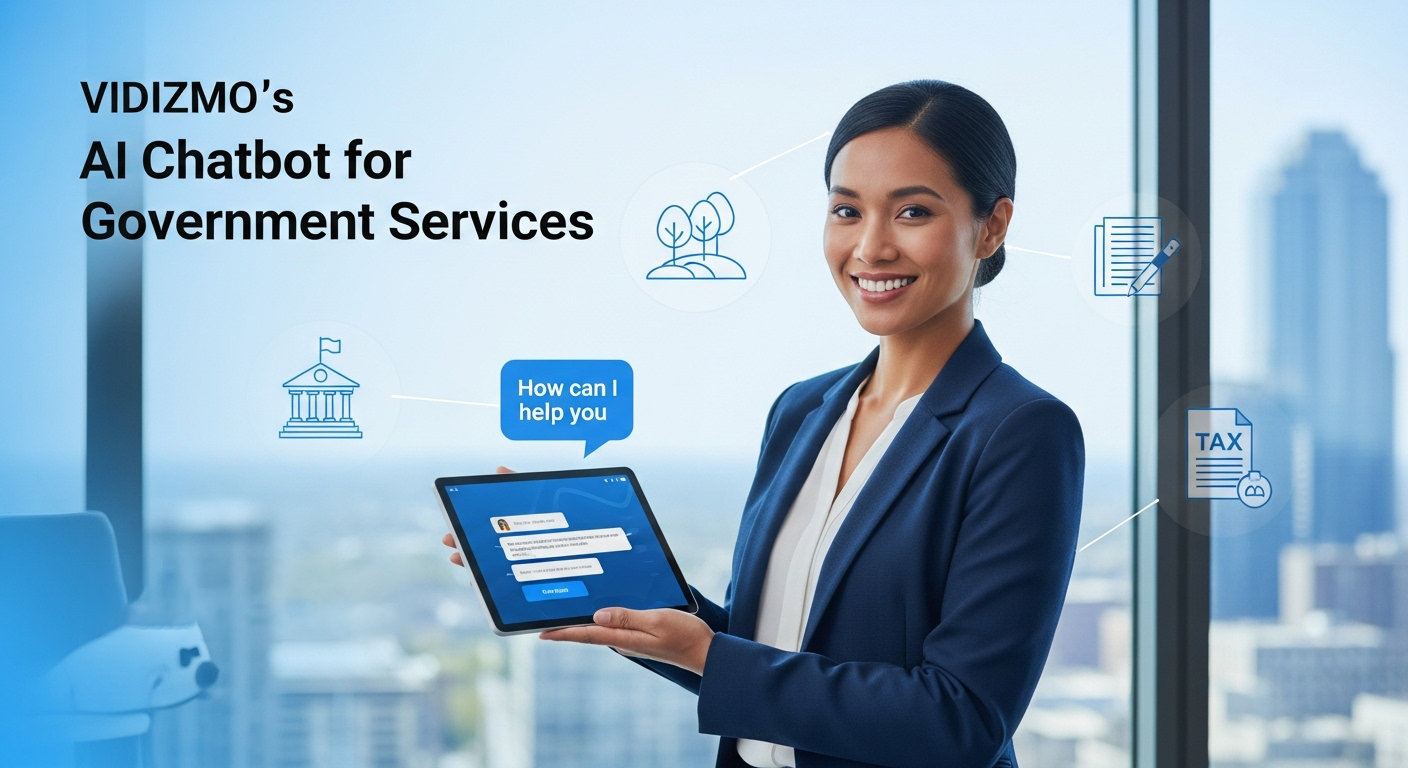AI in public administration is helping state and local government agencies streamline operations, improve service delivery, and enhance public transparency. This blog explores how AI-powered tools such as redaction, transcription, chatbots, and intelligent search are helping administrative departments overcome challenges in FOIA compliance, accessibility, election monitoring, and citizen engagement.
Modern state and local government administration departments are under growing pressure to serve communities more efficiently, transparently, and equitably. From responding to information requests and managing public meetings to handling citizen feedback and securing election processes, the demands are high and often constrained by limited resources.
To meet these challenges, many agencies are turning to artificial intelligence. AI in public administration enables departments to automate manual processes, improve accessibility, and make data-driven decisions. Whether it is redacting sensitive data in FOIA requests or enhancing public service through chatbots and intelligent content search, AI is becoming a practical tool for improving day-to-day operations.
In this blog, we explore how AI-powered solutions are helping administrative departments at the state and local level modernize their workflows, comply with regulations, and deliver better outcomes for the public.
Core Challenges in Public Administration
Administrative departments at the state and local level are central to public service delivery, yet they face ongoing obstacles that hinder efficiency, transparency, and responsiveness. With limited resources and growing demands, addressing these challenges has become essential.

Below are the most common issues agencies encounter, each of which can be addressed through the practical use of AI in public administration.
Manual Redaction Slows FOIA Responses
Handling Freedom of Information Act (FOIA) requests often involves manually redacting sensitive data like personally identifiable information. This process is time-consuming, error-prone, and increases the risk of non-compliance.
Limited Accessibility in Public Meetings
Ensuring that meetings are accessible to individuals with disabilities and non-English speakers is both a legal and ethical priority. Yet, manual transcription and translation can be resource-intensive and may not fully meet ADA or Title VI requirements.
Difficulty in Analyzing Public Sentiment
Departments frequently gather citizen feedback during town halls and online forums. Without AI tools to analyze sentiment and identify themes, valuable insights may be lost, limiting data-informed decision-making.
Election Monitoring Lacks Real-Time Visibility
Maintaining the integrity of elections requires constant surveillance of polling stations and ballot facilities. Traditional monitoring systems lack real-time detection, delaying responses to irregularities and security concerns.
High Volume of Repetitive Public Inquiries
Administrative teams are often overwhelmed with repeated questions about policies, services, and documentation. Without automation, response times lag, and staff bandwidth are reduced.
Poor Access to Internal Documents
Internal records, such as meeting minutes and policy documents, are stored across fragmented systems. This lack of centralized access delays important decisions and reduces overall agility.
How AI in Public Administration Is Solving Key Challenges
Administrative departments are central in ensuring that government services operate efficiently, equitably, and transparently. From handling documentation and ensuring accessibility in public meetings to managing citizen engagement and monitoring elections, these teams face mounting workloads and limited resources.

Agencies are increasingly turning to AI in public administration to meet these growing demands. This technology enables more intelligent workflows by automating repetitive administrative tasks, streamlining access to information, and generating real-time insights. As a result, staff can shift focus from manual processes to more strategic responsibilities that drive better outcomes.
Whether applied to AI in benefits administration or used to improve internal decision-making, artificial intelligence empowers governments to modernize services, improve transparency, and strengthen public trust. These use cases also align with broader goals around using AI in administration effectively and responsibly.
The following sections highlight how specific AI-powered solutions from VIDIZMO are helping government administration departments overcome these operational hurdles.
Improving FOIA Efficiency with AI-Powered Redaction
In the landscape of modern governance, one of the most common applications of AI in public administration is automating compliance-driven workflows such as FOIA responses. Administrative departments handle vast amounts of sensitive information across emails, reports, and meeting records. When fulfilling Freedom of Information Act (FOIA) requests, protecting personally identifiable information (PII) is a legal and ethical priority.
Federal agencies received over 1.5 million FOIA requests in fiscal year 2024, a 25 % increase from the previous year. At year-end, more than 267,000 requests remained pending, underscoring growing workload and backlog challenges.
Manual redaction processes are not only slow but also vulnerable to human error. AI in administrative tasks offers a transformative solution.
VIDIZMO Redactor, powered by AI, automates this process by quickly identifying and removing PII from documents, including names, addresses, contact details, and other sensitive data. This reduces the risk of human oversight while significantly improving turnaround times.
By adopting AI in government administration, departments can respond to FOIA requests more efficiently, reduce operational bottlenecks, and improve transparency. The result is a more responsive public service that earns trust through timely and accurate information sharing.
Enhancing Accessibility in Government Meetings
Administrative departments conduct a wide range of public-facing meetings, including council sessions, committee hearings, budget reviews, and community briefings. These gatherings must meet accessibility and transparency standards under laws such as the Government in the Sunshine Act, the Americans with Disabilities Act (ADA), and Title VI of the Civil Rights Act.
Ensuring that these meetings are inclusive for all residents, including individuals with disabilities or limited English proficiency, is a growing responsibility. VIDIZMO EnterpriseTube helps departments meet these requirements by using AI to automatically transcribe, translate, and caption meeting recordings. This ensures that public content is not only compliant but also easy to understand and accessible in multiple languages.
With these capabilities in place, agencies can reduce manual workloads, improve civic participation, and demonstrate a clear commitment to equitable public service.
Learn how VIDIZMO supports secure video management in federal environments by reading our case study with the U.S. Department of State
Analyzing Community Feedback for Informed Decision-Making
Community feedback is essential for shaping responsive public policies and improving the quality of government services. From town hall meetings and virtual hearings to online forums, this input provides a window into residents' concerns, needs, and priorities. However, sifting through hours of video or written comments manually can be inefficient and inconsistent.
This is a key area where AI in public administration delivers measurable value. VIDIZMO’s Public Engagement Analysis leverages artificial intelligence to analyze video, audio, and text data from public interactions. The system identifies recurring themes, emotional tones, and sentiment patterns, converting unstructured feedback into clear, actionable insights.
By understanding how to use AI effectively in administration, government teams can make more informed decisions, prioritize issues that matter to constituents, and fine-tune services to better reflect public expectations.
For departments involved in community welfare or benefits administration, these insights can also help identify gaps in service delivery and optimize program planning. Integrating AI into this process not only supports data-driven governance but also enhances transparency and deepens public trust.
Enhancing Election Transparency and Security
In the context of AI in public administration, ensuring the security and transparency of elections has become a key priority.
During elections and other high-impact events, administrative departments are tasked with safeguarding both the physical integrity and public credibility of government facilities. This includes oversight of polling stations, ballot storage areas, and other critical zones where transparency is essential.

With VIDIZMO’s customizable Anomaly Detection solution, departments can use existing CCTV or IP camera infrastructure to automatically detect signs of tampering, unauthorized access, or unusual activity. The system can be trained to recognize specific risk patterns and send immediate alerts when irregularities occur, allowing staff to take swift action and reduce potential disruptions.
For administrators looking into how to use AI in administration to boost election oversight, this application demonstrates how technology can extend beyond convenience into the realm of democratic accountability. While not a traditional aspect of AI in benefits administration, it underscores how the same intelligent systems that support social services can also ensure public trust during elections.
To learn more about how election livestreaming supports transparency and public trust, read our blog on livestreaming elections.
Increasing Support Efficiency with AI Chatbots
Chatbots offer a practical entry point for agencies looking to understand how to use AI in administration. Administrative departments manage a steady flow of public inquiries regarding service requests, benefits applications, scheduling, and policy clarifications. Responding to these inquiries manually can strain staff capacity, especially when most questions are routine and time-sensitive.
VIDIZMO’s AI Chatbot provides a scalable solution that automates responses to frequently asked questions as part of broader efforts to implement AI in public administration. The chatbot is integrated with internal knowledge bases, scheduling tools, and communication systems and delivers accurate and consistent real-time information. It also supports internal staff by quickly retrieving procedures, contact details, or system guidance.
This approach benefits agencies involved in AI in benefits administration, where public programs often face high volumes of similar queries. By resolving common issues automatically and routing complex cases to human agents, the chatbot helps reduce response times and ensures better use of staff resources.
AI chatbots improve administrative efficiency, enhance public service delivery, and support a more modern and responsive approach to government operations.
Improving Internal Content Discovery for Better Decision-Making
AI in public administration is transforming how departments access and manage internal information. Government agencies generate a high volume of content, including meeting minutes, policy updates, internal memos, and official records. As this information accumulates across various systems, finding the right document quickly becomes a significant challenge that can slow down critical decisions.
VIDIZMO’s AI-powered search improves content discovery by integrating with existing document management systems. It uses natural language processing to understand search context, extract key terms, and retrieve relevant files even when users do not remember exact titles or file names.
With faster access to essential information, administrative staff can make timely decisions, uphold transparency, and improve governance outcomes. AI empowers teams to work more efficiently and collaboratively across departments by improving accessibility and reducing time spent searching.
Why VIDIZMO Is the Right Partner for Government Administration
As agencies embrace AI in public administration, the need for secure, compliant, and scalable technology becomes more urgent. State and local governments must address unique operational challenges while maintaining transparency, accessibility, and regulatory compliance.
VIDIZMO provides enterprise-grade AI solutions designed specifically for public sector administration. Our platform helps modernise administrative workflows with features like automated redaction, multilingual transcription and translation, intelligent content discovery, and sentiment analysis from public feedback.
We support compliance with FOIA, ADA, Title VI, and the Government in the Sunshine Act, while offering deployment flexibility across cloud, on-premises, and hybrid environments. Whether the goal is to streamline FOIA processing, enhance civic engagement, or improve transparency during elections, VIDIZMO delivers tools that align with both operational needs and public expectations.
To understand how government agencies can adopt responsible AI practices, read our blog on ethical AI in government.
Transforming Government Administration with AI Solutions
Modernizing public service delivery calls for more than small enhancements. It requires a transition to intelligent, scalable, and secure technologies. AI in public administration equips state and local agencies to meet rising demands for transparency, accessibility, and operational efficiency.
From streamlining FOIA redaction and improving internal content discovery to boosting public engagement, AI-powered solutions like those from VIDIZMO help reduce manual workload and enhance service delivery. These tools assist with regulatory compliance, including FOIA and ADA requirements, and build public trust and support informed decision-making.
If your department is ready to adopt smarter, faster, and more inclusive ways to serve the public, contact us or explore our AI solutions for government administration today.
People Also Ask
What are the benefits of using AI in government administration?
AI in government administration helps automate time-consuming tasks, enhance document processing, improve accessibility, and deliver faster public service responses.
How does AI support FOIA compliance for administrative departments?
AI supports FOIA compliance by automatically detecting and redacting personally identifiable information from government documents, ensuring accuracy and timely disclosures.
Why is accessibility important for government meetings?
Accessibility ensures that all citizens, including individuals with disabilities and non-English speakers, can participate in governance and access public information without barriers.
How can AI improve public engagement analysis for local governments?
AI can analyze audio and video data from public forums to extract sentiment, detect recurring themes, and offer actionable insights, helping departments align decisions with community needs.
What role does VIDIZMO play in improving administrative workflows?
VIDIZMO provides AI-driven tools such as redaction, transcription, anomaly detection, and intelligent search that streamline operations, enhance transparency, and reduce manual workloads.
Can AI chatbots reduce the burden on administrative staff?
AI chatbots answer routine public queries in real time, helping departments reduce inquiry volume, accelerate response times, and allow staff to focus on higher-priority issues.
How does automated transcription enhance public service accessibility?
Automated transcription provides real-time, multilingual captions for government meetings and hearings, helping agencies comply with ADA and improve civic engagement.
Is AI useful for internal content discovery in government departments?
AI-powered search tools help administrators locate documents quickly by analyzing content context, reducing decision-making delays, and improving operational transparency.
How does anomaly detection contribute to election security?
AI-based anomaly detection monitors government facilities using existing video infrastructure, flagging suspicious activity to improve oversight and protect electoral integrity.
Is VIDIZMO a trusted government technology provider?
VIDIZMO is a pre-qualified vendor in the Georgia Technology Authority Innovation Lab, making it a reliable partner for state and local agencies seeking secure, compliant AI solutions.






No Comments Yet
Let us know what you think